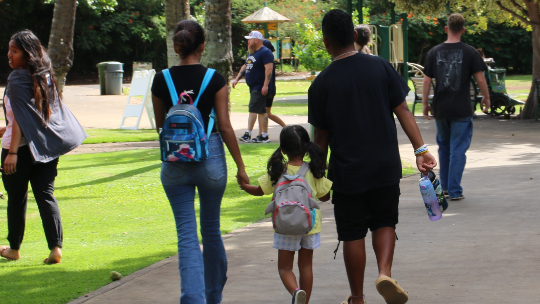One Saturday morning, when I was 7 years old, my siblings and I packed sandwiches, snacks, and juice into a basket. But we weren’t going on a picnic; instead, we were spending our entire day at the local library. I remember being so excited I couldn’t sleep the night before. We sat there for hours, pouring over books (with a break for lunch) before finally going home in the early evening. It’s still one of my fondest childhood memories.
February is National Library Lovers Month, a time to celebrate the importance of libraries and all that they do. The Hawaii State Public Library System (HSPLS) doesn’t have just books; the 51 branches across Oahu, Maui, Big Island, Lanai, Kauai, and Molokai serve as community-based resource hubs. It’s where people go for information, community, and support, whether they’re keiki, students, job seekers, adults, or kupuna.
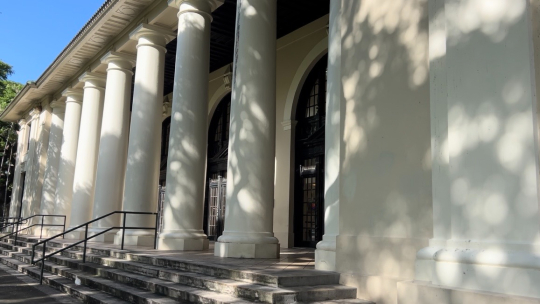
Hawaii State Library in Honolulu.
“Libraries open your eyes to the world,” says Stacey Aldrich, state librarian of the Hawaii State Public Library System. “You can read so many different stories, go online, sign up for language courses and other programs, and connect with other people.”
A sense of community and belonging
Growing up, my family and I visited the library almost every weekend. It was part of our routine: stop by after dance class to return and then borrow a few books for the week. Since my dad was on the board of several organizations, he also hosted community events there. We would occupy a meeting room, mingling and networking with neighbors, friends, and the public.

My dad and I co-hosting a Chinese New Year event at our local library in 2016.
As a teenager, I was at the library so often that I ended up volunteering there. When I wasn’t sorting through returned books and putting them back on shelves, I was browsing the Internet, doing homework, or meeting up with friends for a study session.
“It’s a place to gather to be with other people. But if you want quiet, there’s a space for that, too,” says Aldrich. “Libraries have a little something for everyone — you can find bestsellers or older books you may want to reread. Some people have their special seat where they like to hang out and read the newspaper every morning. Or you may learn Mahjong and make new friends. It’s a place where you’re part of the community.”
Health and wealth (of information)
The HSPLS is unique because it’s the only statewide public library system in the U.S. Each branch also has some distinctive features.
“Liliha Public Library has a Chinese collection and McCully has an extensive Korean collection,” says Aldrich. “You’re going to find things that meet the needs of the community and represent the people who live there.”
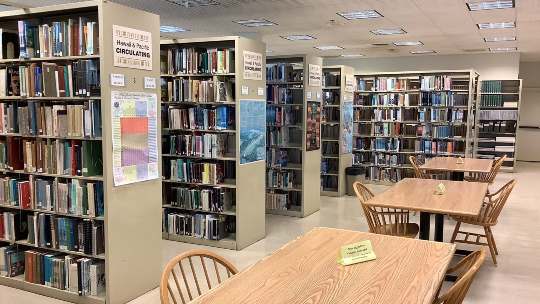
The Hawaii and Pacific section inside Hawaii State Library. Photo courtesy HSPLS
Other resources include computers, printers, and other technology. Patrons can borrow movies, CDs, quilt patterns, sheet music, and even ukuleles. There’s storytime for preschoolers and arts and crafts for teenagers. If you have a library card, you can take a variety of free courses, from language and business writing to college readiness and law.
The State Library for the Blind and Print Disabled helps patrons who have physical challenges reading standard print. There’s an extensive collection of books and magazines in audio, Braille, and large print.
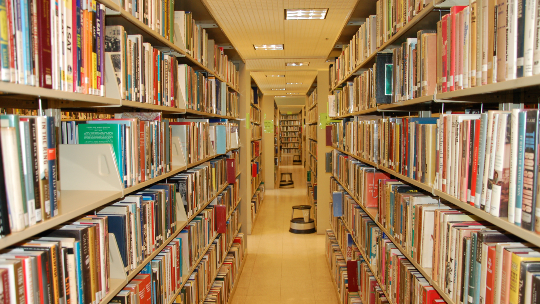
Browse through thousands of books in the Hawaii State Library stacks. Photo courtesy HSPLS
“We want to make sure that everyone has access to the world of stories, information, ideas and learning,” says Aldrich. “They can read books, magazines, and other materials that will help them be successful in their education or career. Our libraries are community hubs that bring together the best of what’s available and connect people to what they are looking for or need.”
The state library system will soon launch a new program to help people stay healthy by connecting those who live in rural areas to medical care. Patrons will be able to visit more than 25 libraries in rural towns and check out laptops and hotspots to use for virtual visits with their doctor, such as through HMSA’s Online Care®. A few of the libraries will also have Telehealth Navigators, who will be able to provide one-on-one coaching and support for telehealth connectivity.
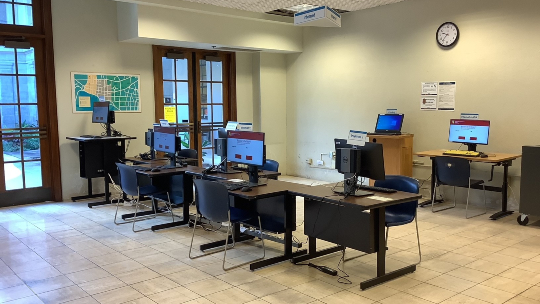
Patrons with a library card can use computers inside the libraries. Photo courtesy HSPLS
“We’ve piloted telehealth support in one of our rural libraries. The patrons who were able to connect were excited they didn’t have to drive all the way to Hilo to get an appointment,” says Aldrich. “And oftentimes there aren’t specialists on the Neighbor Islands, so we hope this partnership with the Department of Health and Pacific Basin Telehealth Resource Center will help close that gap in care.”
The impact of COVID-19
Telehealth services weren’t common before the pandemic hit. But COVID-19 changed how the world worked, and businesses, people, and life had to adjust. In the case of the library, their focus turned to digital content.

Demand for eBooks have surged since the pandemic began.
“We circulated more than a million eBooks in the first year of the pandemic and it goes up each year,” says Aldrich.
The HSPLS recognized the surge in popularity of eBooks and invested more money in its digital collection. It also added a movie streaming service, interactive books, and thousands of magazines and newspapers from around the world.
“For example, if you use PressReader, you can read about what’s happening in France in Le Monde and it will translate into English if you don’t speak French,” says Aldrich. “You can read Vogue from Australia and Brazil and see how different they are from the magazine here.”
Supporting libraries
Going digital isn’t cheap. In fact, it’s now more expensive to run a library than ever before. That’s because libraries buy both paper and digital copies to ensure everyone has access.
“It’s more complicated because we’re leasing the eBook from the publisher — we don’t own it. So it circulates a couple dozen times before we have to pay for it again,” explains Aldrich.
The state allocates $1.5 million every year to fund collections, which is a significant improvement from nine years ago when there was no budget at all, and libraries had to rely solely on fines and fees.
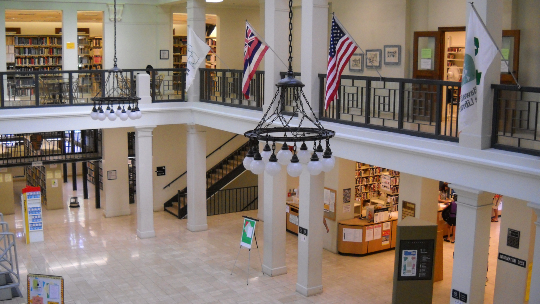
Find books, movies, computers, and more at this community resource hub. Photo courtesy HSPLS
“Investing in libraries means investing in our communities,” says Aldrich. “Supporting libraries can be as easy as letting your representative know how important the library is to you and that their support is needed.”
Turning the page
I visited the Hawaii State Library on a weekday afternoon. While it’s in the middle of busy Honolulu, it was quiet and peaceful inside, with several people listening to music, reading, or working at tables on the lanai. In the children’s room, a mother was reading aloud to her toddler who was listening with interest.

An interactive storytime inside the Edna Allyn Room for Children. Photo courtesy HSPLS
“It’s exciting to see generations of people bring their experience to the next generation and share their ‘library story,’” says Aldrich. “Everyone has one; there’s an emotional connection to libraries because they’re not just about books. They’re about ideas and stories and connecting people.
“We want to continue to be that place where people can connect as humans, even with technology. It’s not anything new — it’s just extending into new worlds of information.”
Book lovers unite!
Team HMSA is always adding books to our “to be read” list! Jessika Orozco, HMSA’s PR and social media specialist, and I talk story about our favorite reads and the impact libraries have had on us:
Amwell is an independent company providing hosting and software services for HMSA's Online Care platform on behalf of HMSA.

